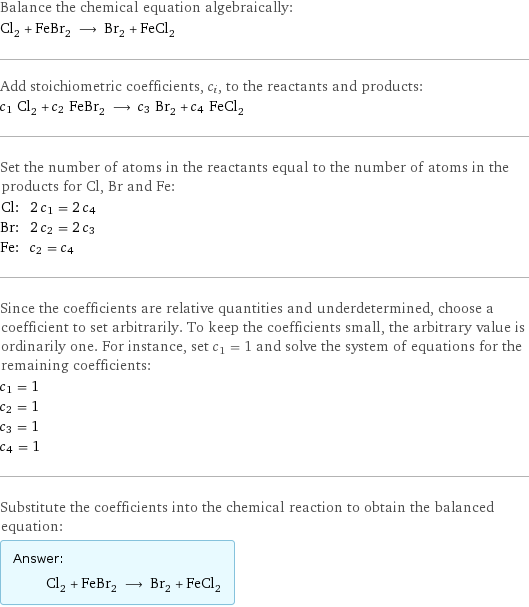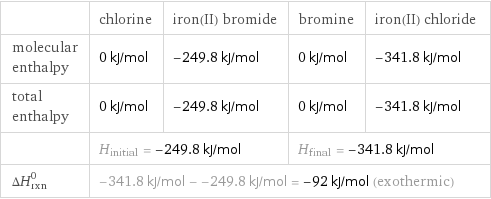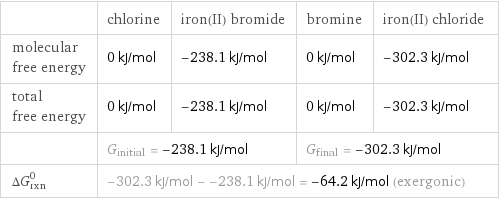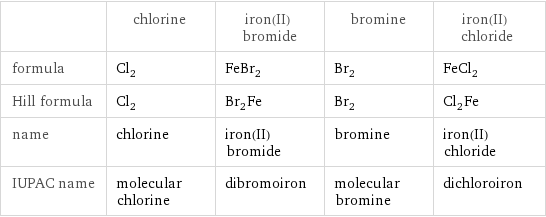Input interpretation

Cl_2 chlorine + FeBr_2 iron(II) bromide ⟶ Br_2 bromine + FeCl_2 iron(II) chloride
Balanced equation

Balance the chemical equation algebraically: Cl_2 + FeBr_2 ⟶ Br_2 + FeCl_2 Add stoichiometric coefficients, c_i, to the reactants and products: c_1 Cl_2 + c_2 FeBr_2 ⟶ c_3 Br_2 + c_4 FeCl_2 Set the number of atoms in the reactants equal to the number of atoms in the products for Cl, Br and Fe: Cl: | 2 c_1 = 2 c_4 Br: | 2 c_2 = 2 c_3 Fe: | c_2 = c_4 Since the coefficients are relative quantities and underdetermined, choose a coefficient to set arbitrarily. To keep the coefficients small, the arbitrary value is ordinarily one. For instance, set c_1 = 1 and solve the system of equations for the remaining coefficients: c_1 = 1 c_2 = 1 c_3 = 1 c_4 = 1 Substitute the coefficients into the chemical reaction to obtain the balanced equation: Answer: | | Cl_2 + FeBr_2 ⟶ Br_2 + FeCl_2
Structures

+ ⟶ +
Names

chlorine + iron(II) bromide ⟶ bromine + iron(II) chloride
Reaction thermodynamics
Enthalpy

| chlorine | iron(II) bromide | bromine | iron(II) chloride molecular enthalpy | 0 kJ/mol | -249.8 kJ/mol | 0 kJ/mol | -341.8 kJ/mol total enthalpy | 0 kJ/mol | -249.8 kJ/mol | 0 kJ/mol | -341.8 kJ/mol | H_initial = -249.8 kJ/mol | | H_final = -341.8 kJ/mol | ΔH_rxn^0 | -341.8 kJ/mol - -249.8 kJ/mol = -92 kJ/mol (exothermic) | | |
Gibbs free energy

| chlorine | iron(II) bromide | bromine | iron(II) chloride molecular free energy | 0 kJ/mol | -238.1 kJ/mol | 0 kJ/mol | -302.3 kJ/mol total free energy | 0 kJ/mol | -238.1 kJ/mol | 0 kJ/mol | -302.3 kJ/mol | G_initial = -238.1 kJ/mol | | G_final = -302.3 kJ/mol | ΔG_rxn^0 | -302.3 kJ/mol - -238.1 kJ/mol = -64.2 kJ/mol (exergonic) | | |
Equilibrium constant
![Construct the equilibrium constant, K, expression for: Cl_2 + FeBr_2 ⟶ Br_2 + FeCl_2 Plan: • Balance the chemical equation. • Determine the stoichiometric numbers. • Assemble the activity expression for each chemical species. • Use the activity expressions to build the equilibrium constant expression. Write the balanced chemical equation: Cl_2 + FeBr_2 ⟶ Br_2 + FeCl_2 Assign stoichiometric numbers, ν_i, using the stoichiometric coefficients, c_i, from the balanced chemical equation in the following manner: ν_i = -c_i for reactants and ν_i = c_i for products: chemical species | c_i | ν_i Cl_2 | 1 | -1 FeBr_2 | 1 | -1 Br_2 | 1 | 1 FeCl_2 | 1 | 1 Assemble the activity expressions accounting for the state of matter and ν_i: chemical species | c_i | ν_i | activity expression Cl_2 | 1 | -1 | ([Cl2])^(-1) FeBr_2 | 1 | -1 | ([FeBr2])^(-1) Br_2 | 1 | 1 | [Br2] FeCl_2 | 1 | 1 | [FeCl2] The equilibrium constant symbol in the concentration basis is: K_c Mulitply the activity expressions to arrive at the K_c expression: Answer: | | K_c = ([Cl2])^(-1) ([FeBr2])^(-1) [Br2] [FeCl2] = ([Br2] [FeCl2])/([Cl2] [FeBr2])](../image_source/b32cafc8a222c04f4fe5d2bcbf10aa3c.png)
Construct the equilibrium constant, K, expression for: Cl_2 + FeBr_2 ⟶ Br_2 + FeCl_2 Plan: • Balance the chemical equation. • Determine the stoichiometric numbers. • Assemble the activity expression for each chemical species. • Use the activity expressions to build the equilibrium constant expression. Write the balanced chemical equation: Cl_2 + FeBr_2 ⟶ Br_2 + FeCl_2 Assign stoichiometric numbers, ν_i, using the stoichiometric coefficients, c_i, from the balanced chemical equation in the following manner: ν_i = -c_i for reactants and ν_i = c_i for products: chemical species | c_i | ν_i Cl_2 | 1 | -1 FeBr_2 | 1 | -1 Br_2 | 1 | 1 FeCl_2 | 1 | 1 Assemble the activity expressions accounting for the state of matter and ν_i: chemical species | c_i | ν_i | activity expression Cl_2 | 1 | -1 | ([Cl2])^(-1) FeBr_2 | 1 | -1 | ([FeBr2])^(-1) Br_2 | 1 | 1 | [Br2] FeCl_2 | 1 | 1 | [FeCl2] The equilibrium constant symbol in the concentration basis is: K_c Mulitply the activity expressions to arrive at the K_c expression: Answer: | | K_c = ([Cl2])^(-1) ([FeBr2])^(-1) [Br2] [FeCl2] = ([Br2] [FeCl2])/([Cl2] [FeBr2])
Rate of reaction
![Construct the rate of reaction expression for: Cl_2 + FeBr_2 ⟶ Br_2 + FeCl_2 Plan: • Balance the chemical equation. • Determine the stoichiometric numbers. • Assemble the rate term for each chemical species. • Write the rate of reaction expression. Write the balanced chemical equation: Cl_2 + FeBr_2 ⟶ Br_2 + FeCl_2 Assign stoichiometric numbers, ν_i, using the stoichiometric coefficients, c_i, from the balanced chemical equation in the following manner: ν_i = -c_i for reactants and ν_i = c_i for products: chemical species | c_i | ν_i Cl_2 | 1 | -1 FeBr_2 | 1 | -1 Br_2 | 1 | 1 FeCl_2 | 1 | 1 The rate term for each chemical species, B_i, is 1/ν_i(Δ[B_i])/(Δt) where [B_i] is the amount concentration and t is time: chemical species | c_i | ν_i | rate term Cl_2 | 1 | -1 | -(Δ[Cl2])/(Δt) FeBr_2 | 1 | -1 | -(Δ[FeBr2])/(Δt) Br_2 | 1 | 1 | (Δ[Br2])/(Δt) FeCl_2 | 1 | 1 | (Δ[FeCl2])/(Δt) (for infinitesimal rate of change, replace Δ with d) Set the rate terms equal to each other to arrive at the rate expression: Answer: | | rate = -(Δ[Cl2])/(Δt) = -(Δ[FeBr2])/(Δt) = (Δ[Br2])/(Δt) = (Δ[FeCl2])/(Δt) (assuming constant volume and no accumulation of intermediates or side products)](../image_source/f3114c291e6afb6668b465f952b5f28f.png)
Construct the rate of reaction expression for: Cl_2 + FeBr_2 ⟶ Br_2 + FeCl_2 Plan: • Balance the chemical equation. • Determine the stoichiometric numbers. • Assemble the rate term for each chemical species. • Write the rate of reaction expression. Write the balanced chemical equation: Cl_2 + FeBr_2 ⟶ Br_2 + FeCl_2 Assign stoichiometric numbers, ν_i, using the stoichiometric coefficients, c_i, from the balanced chemical equation in the following manner: ν_i = -c_i for reactants and ν_i = c_i for products: chemical species | c_i | ν_i Cl_2 | 1 | -1 FeBr_2 | 1 | -1 Br_2 | 1 | 1 FeCl_2 | 1 | 1 The rate term for each chemical species, B_i, is 1/ν_i(Δ[B_i])/(Δt) where [B_i] is the amount concentration and t is time: chemical species | c_i | ν_i | rate term Cl_2 | 1 | -1 | -(Δ[Cl2])/(Δt) FeBr_2 | 1 | -1 | -(Δ[FeBr2])/(Δt) Br_2 | 1 | 1 | (Δ[Br2])/(Δt) FeCl_2 | 1 | 1 | (Δ[FeCl2])/(Δt) (for infinitesimal rate of change, replace Δ with d) Set the rate terms equal to each other to arrive at the rate expression: Answer: | | rate = -(Δ[Cl2])/(Δt) = -(Δ[FeBr2])/(Δt) = (Δ[Br2])/(Δt) = (Δ[FeCl2])/(Δt) (assuming constant volume and no accumulation of intermediates or side products)
Chemical names and formulas

| chlorine | iron(II) bromide | bromine | iron(II) chloride formula | Cl_2 | FeBr_2 | Br_2 | FeCl_2 Hill formula | Cl_2 | Br_2Fe | Br_2 | Cl_2Fe name | chlorine | iron(II) bromide | bromine | iron(II) chloride IUPAC name | molecular chlorine | dibromoiron | molecular bromine | dichloroiron
Substance properties

| chlorine | iron(II) bromide | bromine | iron(II) chloride molar mass | 70.9 g/mol | 215.65 g/mol | 159.81 g/mol | 126.7 g/mol phase | gas (at STP) | solid (at STP) | liquid (at STP) | solid (at STP) melting point | -101 °C | 684 °C | -7.2 °C | 677 °C boiling point | -34 °C | 934 °C | 58.8 °C | density | 0.003214 g/cm^3 (at 0 °C) | 4.63 g/cm^3 | 3.119 g/cm^3 | 3.16 g/cm^3 solubility in water | | | insoluble | surface tension | | | 0.0409 N/m | dynamic viscosity | | | 9.44×10^-4 Pa s (at 25 °C) |
Units
